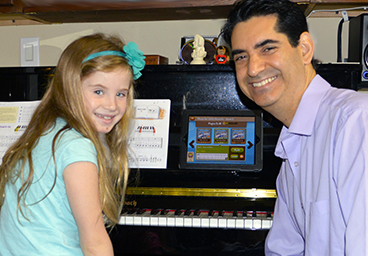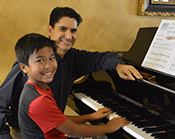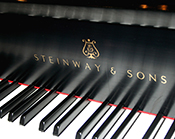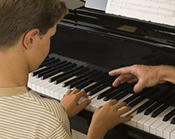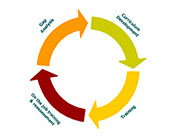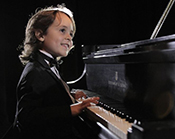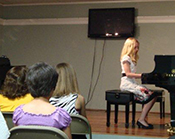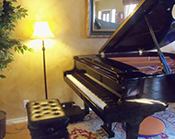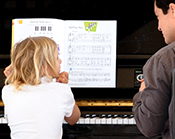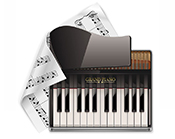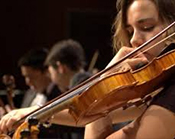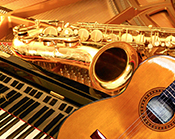Frequently Asked Questions
About the Suzuki Method
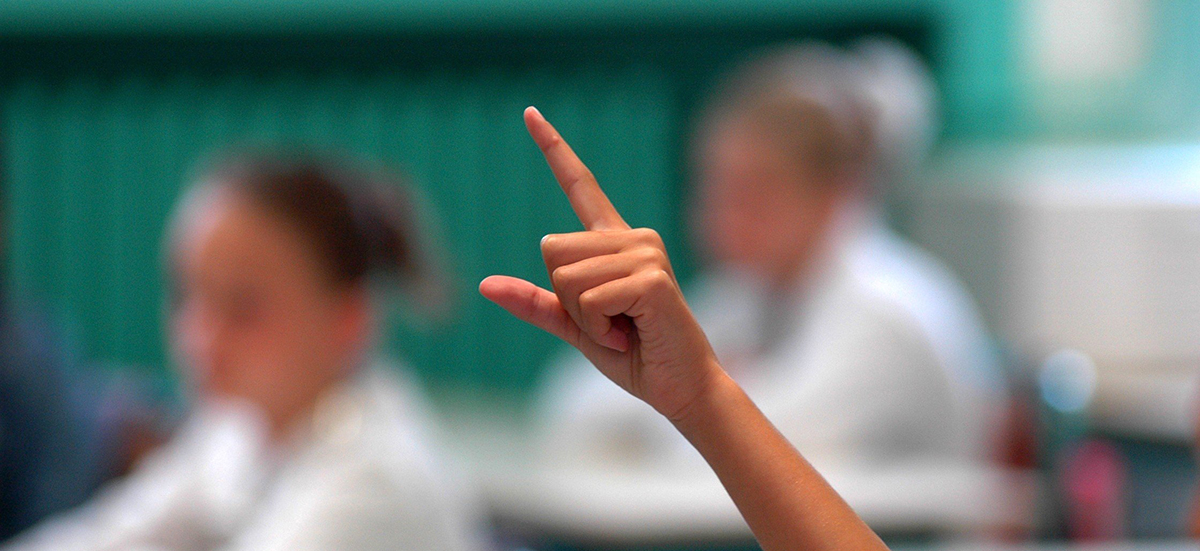
- What's a good age to start Suzuki training?
- What is the course of study like?
- How are lessons set up?
- Is it true that Suzuki students do not learn to read music?
- What commitment is required on the part of parents?
- As a parent, how am I involved?
- How do I know if my child is ready for lessons or has an aptitude for piano?
- What style of music do Suzuki students study?
- Can special needs children learn to play the piano?
- Why do you require that students have an acoustic (not electronic) piano?
- Why do you require adjustable seating equipment?
- How does the Suzuki Method differ from other methods of teaching music to children?
- What is a musical environment?
What's a good age to start Suzuki training?
It is good to begin as early as possible and the Suzuki Method makes it possible for children to begin at an earlier age than more traditional approaches. Generally, students are ready to begin formal musical study by age 4.
What is the course of study like?
Students advance at their own pace through a curriculum consisting of small steps that lead to the mastery of musical skills. Good form, poise, technical mastery, beautiful tone, accurate intonation, and fine musical phrasing become part of the student's training from the beginning. The progressive repertory of pieces forms the basis for developing solid technique and musical sensitivity.
How are lessons set up?
Suzuki Method concepts are applied, and lessons are structured to provide individualized instruction within the lesson setting. Also in group lessons, children work together and have the opportunity to perform for others on a regular basis, enabling them to develop musical fluency. They learn to feel ease when playing for others.
Is it true that Suzuki students do not learn to read music?
No necessarily. While Suzuki students learn to play with natural facility before they actually read music, I teach preparatory music reading concurrently with the first level of the method. Well-taught Suzuki students become proficient, natural readers.
What commitment is required on the part of parents?
Parents play a daily role in their child's music education by helping them carry out practice assignments, much in the same way that they help their children complete school homework assignments. Suzuki students are not expected to shoulder the entire responsibility for practice until they are teenagers. With a parent acting as a "personal trainer" at home, the dropout rate among Suzuki students is significantly lower than in traditional methods.
One parent is designated to attend lessons in order to understand assignments and how to practice at home. It is not necessary that this parent have had any music education of his/her own. Starting at the beginning, it is easy for any parent to understand music to the extent required to provide strong, ongoing support for the child.
As a parent, how am I involved?
The parent's role starts with creating a musical environment for the child to absorb. However, the parent should never give the impression that they are doing this for their benefit only. Enjoy the music yourself and your child will join in. The parent comes to every lesson and takes careful notes to ensure that the exact assignment is practiced at home. The parent need not be a musician to be a good "practice partner". With your teacher's guidance each parent can learn the basics required. The parent's close involvement in the training process creates a special opportunity for parent and child bonding through positive shared experience.
How do I know if my child is ready for lessons or has an aptitude for piano?
A basic philosophy of the Suzuki Method is that most children can be taught to play an instrument to a high level. We believe that musical talent is not inborn, but the result of a child's environment and education.
The normal age range in which young children are ready to begin their own individual lessons is from 4-5 years old. After the age of five, nearly all children may be considered ready.
Individually, parents are welcome to bring children regularly to observe lessons and to attend performances. Children develop readiness after being placed regularly in a musical environment for a period of time.
The most important element of readiness is the parents' commitment to providing music education for their child.
What style of music do Suzuki students study?
The Suzuki Piano repertoire consists of western classical music, pieces by all the familiar composers: Bach, Mozart, Haydn, Beethoven, Schumann, to name a few. There are seven published books of repertoire, after which students may continue studying an established series of classical pieces designed to increase technique and ability.
After completion of the seven books, students are fully prepared to enter collegiate music programs.
Along the way, many of my students branch out into other styles of playing when they utilize their skills in school, religious, or other community activities. A strong classical foundation allows an easy transition to other styles.
Can special needs children learn to play the piano?
Yes they can. Things that may be considered hindrances to learning in the classroom environment may actually benefit the music student. Each student progresses at his or her own pace, and all are able to advance with the encouragement and support of parents, teachers, and peers.
In the aural world of music, blind students have an especially keen aptitude. Children who have difficulty with focus and concentration may use the study of piano to develop these skills in all areas of their lives.
I am not concerned with diagnoses, but rather to teach the fingers, ears, and heart of the individual child.
Why do you require that students have an acoustic (not electronic) piano?
We teach the physical aspect of producing sound with the most relaxed and concentrated body, using the least amount of effort. Training the body in this way requires that the student is relating to the real, physical world, producing sound mechanically, with a felt hammer, set into motion by the finger touching a key, and then striking a metal string. The ear can guide the body to manipulate sound produced in this way.
Electronically produced sound is a virtual thing, a step away from the physical world. Hearing it day-after-day deadens the ear's natural relationship to real sound. Students who practice on an electronic instrument develop weak technique and an inability to discern the wide range of physical sound that may be produced on a piano.
Why do you require adjustable seating equipment?
The Suzuki Method has made some adaptations to allow small children to begin the study of violin and cello, giving young children child-size instruments and bows and increasing these sizes gradually as the students grow up.
There is no reason that a small child needs a small piano, however, but how any player, not just a child, is seated at the piano is all-important in learning body alignment and balance, things that allow human beings to accomplish astounding physical feats (consider gymnastics, karate, ice skating, horseback riding, to name a few). All serious pianists use an adjustable chair or bench. Not only is there a wide range of seating heights required for various differences in human body sizes and shapes, but an individual pianist needs to be able to adjust the height of the seat from day-to-day depending on how the body is feeling, or on the type of piece being performed. An adjustable chair is as essential as choosing the right size tennis racket or skis.
In the case of young children, adjustable footrests are also required so that the feet have stable contact with the floor no matter what height the chair. This firm contact is essential in developing good balance and control at the piano.
Students who try to practice piano without the benefit of adjustable seating equipment struggle against a great handicap. Removing this obstacle gives students the opportunity to succeed. Good tools are required to do the best job.
How does the Suzuki Method differ from other methods of teaching music to children?
Here are some of the basic differences:
- • Suzuki teachers believe that musical ability can be developed in all children.
- • Students begin at young ages.
- • Parents play an active role in the learning process.
- • Children become comfortable with the instrument before learning to read music.
- • Technique is taught in the context of pieces rather than through dry technical exercises.
- • Pieces are refined through constant review.
- • Students perform frequently.
Other aspects of the Suzuki method are:
- • Fosters close parent/child relationships.
- • Develops physical and aural awareness.
- • Teaches concentration.
- • Builds self-esteem and self-confidence.
- • Demonstrates the giving and receiving of respect
- • The Suzuki teachers' goal is to assist in the creation of noble human beings with lives enriched by music.
What is a musical environment?
Listening to the Suzuki repertoire is part of the foundation of the Suzuki Method. Repeated listening helps the student to be familiar with the repertoire and thus the learning process is facilitated. The student will absorb the language of music just as they do their mother tongue language. Whether in an active or passive listening state, their musical environment directly influences children. Listening to beautiful music on a regular basis as opposed to one that is discordant, vapid or full of rage, can only help to encourage the child towards Dr. Shinichi Suzuki's goal. As he said, "Teaching music is not my main purpose. I want to make good citizens, noble human beings. If a child hears fine music from the day of his birth, and learns to play it himself, he develops sensitivity, discipline and endurance. He gets a beautiful heart."
